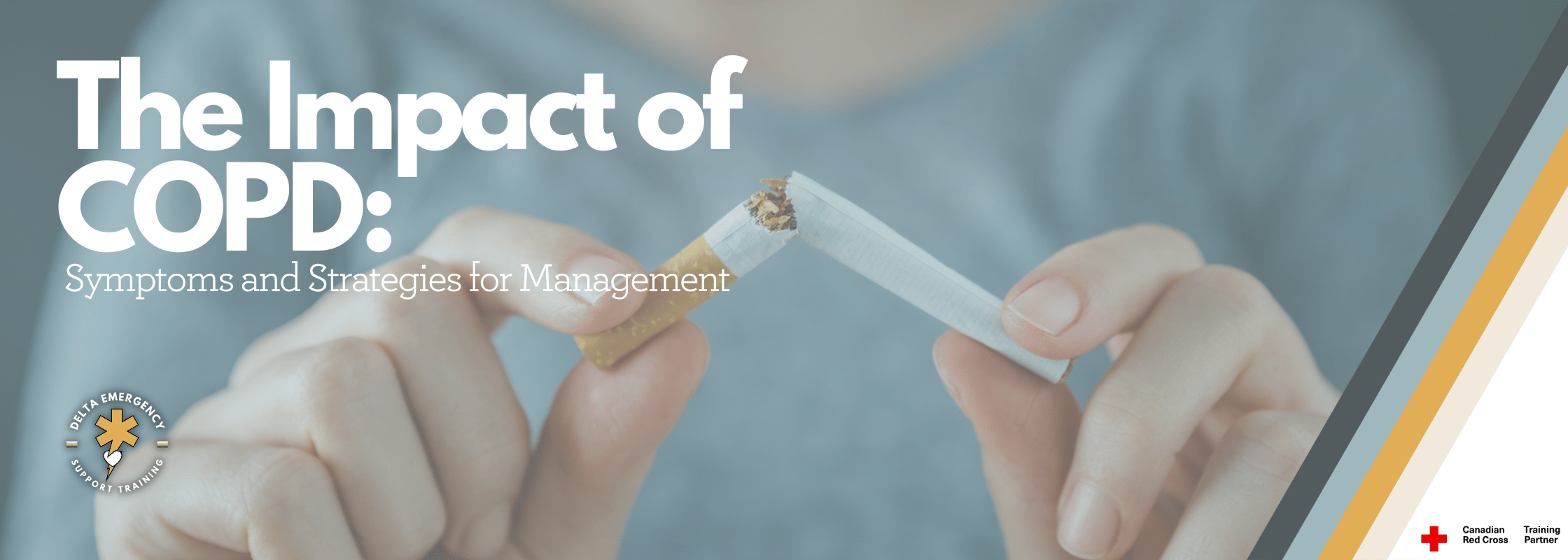The Impact of COPD: Symptoms and Strategies for Management
/Chronic Obstructive Pulmonary Disease (COPD): Understanding Causes, Symptoms, and Treatment
a close-up view of a person's hand holding a cigarette that has been broken in half. The cigarette appears to be made of white paper with tobacco inside.
Chronic Obstructive Pulmonary Disease (COPD) is a common respiratory disease that affects millions of people worldwide. It's a progressive disease that causes damage to the lungs, making it difficult to breathe. COPD encompasses several conditions, including chronic bronchitis and emphysema. In this blog, we will discuss what COPD is, what causes it, the symptoms of COPD, and the available treatments for COPD.
What is COPD?
COPD is a progressive disease that causes damage to the lungs and makes it increasingly difficult to breathe. The main characteristic of COPD is obstruction in the airflow, which occurs due to inflammation and narrowing of the airways, as well as damage to the lung tissue itself. The damage to the lungs is irreversible, and over time, the condition worsens.
What causes COPD?
The primary cause of COPD is cigarette smoking. Other causes of COPD include exposure to air pollution, occupational dust, and chemicals. Genetics can also play a role in the development of COPD.
Symptoms of COPD
The symptoms of COPD may not appear until the condition has already caused significant damage to the lungs. COPD is characterized by several symptoms, including shortness of breath, coughing, wheezing, chest tightness, and excess mucus production. As the disease progresses, these symptoms can worsen and make it increasingly difficult to breathe. In some cases, individuals with COPD may also experience other symptoms such as fatigue, weight loss, and frequent respiratory infections.
Barrel Chest
Barrel chest is a physical characteristic that is commonly seen in individuals with COPD. It is caused by a combination of factors, including overinflation of the lungs, flattened diaphragm, and changes in the shape of the ribcage. As a result, the chest takes on a rounded, barrel-like shape. This can make it difficult for the lungs to expand fully, further exacerbating the symptoms of COPD.
Emphysema
Emphysema is a type of COPD that specifically affects the air sacs in the lungs, causing them to become damaged and lose their elasticity. This damage makes it difficult for the air sacs to empty properly, trapping air in the lungs and causing them to become overinflated. As a result, individuals with emphysema often have difficulty breathing, especially when exhaling.
Difficulty Sleeping Lying Down
Many individuals with COPD experience difficulty sleeping lying down, a condition known as orthopnea. This is because lying flat can make it more difficult for the lungs to expand fully, leading to shortness of breath and coughing. To manage this symptom, individuals may sleep with their head elevated using a wedge pillow or sleep in a recliner chair.
How is COPD diagnosed?
To diagnose COPD, healthcare providers typically start by taking a detailed medical history and conducting a physical exam. Diagnostic tests may include pulmonary function tests, chest x-rays, and CT scans. Spirometry, a simple breathing test, can be used to assess lung function and determine the severity of COPD.
Treatments for COPD
Although there is no cure for COPD, there are several treatments available that can help manage symptoms and slow the progression of the disease. These treatments include medications, lifestyle changes, and oxygen therapy.
Medications:
There are several types of medications available for treating COPD, including bronchodilators, corticosteroids, and phosphodiesterase-4 inhibitors. Bronchodilators work by relaxing the muscles around the airways, making it easier to breathe. Corticosteroids can reduce inflammation in the airways, while phosphodiesterase-4 inhibitors can reduce the frequency of COPD exacerbations.
Lifestyle changes:
Making lifestyle changes can also be beneficial for individuals with COPD. This includes quitting smoking, avoiding exposure to environmental pollutants, and getting regular exercise. Pulmonary rehabilitation programs can also help improve lung function and quality of life.
Oxygen therapy:
Oxygen therapy may be recommended for individuals with severe COPD. This involves using supplemental oxygen to help improve oxygen levels in the blood, which can help reduce shortness of breath and improve quality of life.
How COPD affects everyday life and how to help
COPD can have a significant impact on everyday life, making it difficult to perform simple tasks and reducing quality of life. Some of the ways to help individuals with COPD include:
Encouraging them to quit smoking
Helping them avoid environmental pollutants
Encouraging regular exercise
Helping them maintain a healthy diet
Providing emotional support and encouragement
In conclusion, COPD is a chronic respiratory condition that can significantly impact an individual's quality of life. It's essential to be aware of the symptoms of COPD and seek medical attention if they are present. Quitting smoking and making lifestyle changes, such as regular exercise and a healthy diet, can help manage the symptoms of COPD.
In our advanced first aid training class, we cover topics such as breathing management and pulmonary diseases to equip you with the knowledge and skills to provide excellent care in emergency situations.
At Delta Emergency, we are dedicated to providing you with the tools you need to confidently handle any emergency situation. If you have any questions or concerns about our training programs, please don't hesitate to contact us at info@deltaemergency.com. We're here to support you every step of the way.




